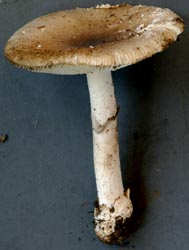[ Section Caesareae page. ]
[ Amanita Studies home. ]
[ Keys & Checklist/Picturebooks ]
[ Great Smoky Mtns. N.P. & region list ]
[ New Jersey & region list ]
[ E. Texas & Gulf Coast list ]
"Hated Caesar"

Technical description (t.b.d.)
BRIEF DESCRIPTION: The cap of A. spreta is 58 - 154 mm wide, whitish or with pallid tints of gray and/or brown at first, often darkening to gray-brown or brown-gray, often darkest in the center, often white or nearly white at the margin, having minute colorless spots and/or giving the impression of densely placed radial fibers embedded in the cap skin. In addition, the cap is broadly campanulate to plano-convex, and eventually has a large umbo in a slight depression. The cap is viscid to tacky and dull to shiny to subshiny with drying, and it has a decurved, nonappendiculate and short-striate margin (striate region occupying 5 - 20% of the radius). The volva is absent or present as white to pale gray, scant, irregular patches, soft to smooth, easily removable, and membranous. The flesh is white, pale brown under the cap skin in the center, 8 - 17 mm thick over the stem, and thinning evenly towards the margin.
The gills are free, receding at maturity, very crowded to crowded, pale cream to cream to white, 8 - 19 mm broad, broadest at the midpoint, anastomosing, with faint and short decurrent lines on the top of the stem, and with a minutely powdery edge. The short gills are truncate to rounded truncate to subtruncate, unevenly distributed, of diverse lengths, and plentiful (sometimes more plentiful than full-length gills). The short gills can be adjacent to the stipe or adjacent to the cap margin or neither.
The stem is 63 - 190 × 8 - 18 mm, slightly narrowing upward to totally elongating, just barely flaring at the top, white, with distinct even layer of pulverulence above the ring, with longitudinally oriented darkening fibrils below the ring, and subsquamulous near the top of the saccate volva. The ring is membranous, flaring, white to off-white to sordid, somewhat grayish at the edge, often darker gray with aging, persistent, superior, collapsing on the stem, finely striate above, and subfibrillose to finely pulverulent on the underside. The flesh of the stem is pale cream, hollow, and lined with loosely interwoven glistening white fibrils. The saccate volva is 18 - 68 × 11.5 - 31 mm, soft and smooth to leathery, white, membranous, tough, with the interior sometimes having a water-soaked appearance, with a small limbus internus, and eventually becoming appressed to the stem. The volva is white on the outer surface and faintly brown on the inner surface.
The spores measure (7.7-) 9.4 - 13.1 (-15.5) × (5.2-) 5.9 - 7.8 (-9.0) µm, and are ellipsoid to elongate (infrequently cylindric) and inamyloid. Clamps are present at bases of basidia.
This species is known from Prov. Québec, Canada to the US states along the Gulf of Mexico in mixed hardwood and hardwood-conifer forests in association with oaks (Quercus alba, Q. ruber, etc.), Birch (e.g., Betula populifolia), Carya, Ostrya, pines (e.g., Pinus rigida), American Beech (Fagus grandifolia), in a variety of soils. So far as is known, its range is limited to North America. [For information about past errors regarding distribution of A. spreta, see A. bresadolana Neville & Poumarat.]
This species is the only species of stirps Caesarea [see A.
caesarea (Scop.) Pers.] known to occur north of Mexico in the Western Hemisphere.
-- R. E. Tulloss and L. Possiel.
Photo: R. E. Tulloss (GSMNP, North Carolina)
[ Section Caesareae page. ]
[ Amanita Studies home. ]
[ Keys & Checklist/Picturebooks ]
[ Great Smoky Mtns. N.P. & region list ]
[ New Jersey & region list ]
[ E. Texas & Gulf Coast list ]
Last change 8 March 2009
This page is maintained by R. E. Tulloss.
Copyright 2006, 2009 by Rodham E. Tulloss.
Photograph copyright 2006 by R. E. Tulloss.